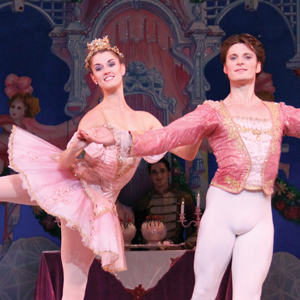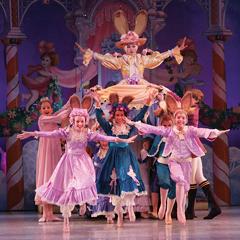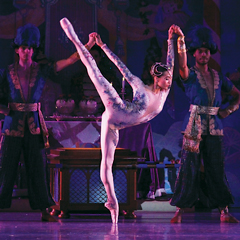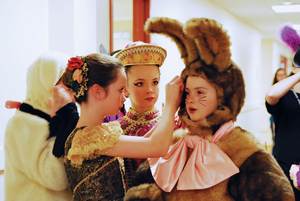
Richmond Ballet company dancer Valerie Tellmann remembers checking the casting list five times before it really sank in that she was going to dance the coveted role of Clara in The Nutcracker.
“My mom told me before the audition not to get my hopes up because I had just joined the school,” says Tellmann, who at that time was twelve and a student in The School of Richmond Ballet. “I really felt very lucky to have that opportunity.”
Today her peers in the ballet lovingly refer to the 33-year-old ballerina as the “crazy Clara” because she was the only Clara who talked to her nutcracker. “People would tell me ‘You got the character,’” Tellmann says with a laugh. “It was total immersion.”
The holiday season in Richmond wouldn’t be complete without Richmond Ballet’s grand production of The Nutcracker. The legendary ballet has become a holiday tradition for countless families in Richmond, and now also Norfolk. Putting the massive ballet together is a tremendous undertaking – one that starts in September when the school’s director, Judy Jacob, pulls out the show’s music and choreography. Jacob has danced in the show and worked with the production for more than twenty years.
“Sometimes you feel a little jaded,” she says. “But the minute you have rehearsal and see it through the eyes of the children, you don’t care that you have done this a thousand times before. It’s such an amazing phenomenon.”
The show has a total of 217 dancers, which includes 169 children, ages seven to eighteen. “We have two casts of students in the two cities,” Jacob says, noting that the Richmond show is cast with students from the school. “When we audition in Norfolk, people come from about twenty dance schools in the Hampton Roads area. Pulling students together from different schools is challenging.”
Children in the production start rehearsing the beginning of October. School manager and child wrangler Rebecca Weger is the point person for parents of the dancers as well as the young dancers when they are backstage. “Being backstage with the children is one of the fun parts of my job,” she says. “I know they are so excited about going on stage and being part of the professional production.”
Keeping up with dozens of children and making sure all goes smoothly during the production is a Herculean task for Weger. She handles everything from hair mishaps to wayward children. “We have little things happening all the time,” she says.
She recalls running to the stage during a dress rehearsal one year because one of the young dancers in the Mother Ginger number appeared to be AWOL. Mother Ginger is a larger-than-life storybook-inspired character with a tent-like skirt large enough to hide eight students dressed as bunnies. “Her hair got stuck on a hook under the Mother Ginger dress,” she says of the missing bunny. “She was stuck under the dress during the whole dance and she was crying.”

Backstage, the children are assigned dressing rooms according to their roles – mice in one room, lambs in another, etc. Weger is responsible for helping to dress all of the children for their roles. “Each costume has a hairdo,” she says. “It’s almost like a hair and makeup salon backstage. We have to make the children look perfect. Every wispy has to be glued to their head.”
The professional dancers in the cast often interact with the children as they wait to go on stage. “Many of them have been these children,” Jacob says. “They are really good about talking to the kids and hugging them. It keeps the children focused
and comfortable.”
Blair Bigelow, who served as wardrobe manager from 2005 to 2013, is also a backstage regular. “The most challenging part of the show is the sheer volume of costumes we have in our production, close to 250,” she says.
The production has a lead dresser and two to three support dressers, as well as a full-time person that maintains wigs. “Every costume has some sort of accessory or extra piece – a glove, hat, hair bow, a moustache. There are a lot of little pieces we have to keep up with.”
Many of the costumes have multiple elements as well. “Something that looks simple on stage can be quite complex,” Bigelow says. “In the fathers’ party scene, for example, the male dancers wear full tuxedos with gloves and facial hair. Most of the fathers become adult mice so they have to come off stage and immediately put on their rat costumes.”
Female dancers who appear as party moms in the scene are decked out in corseted gowns complete with pettipants and backside bump pads to create a tiny Victorian waist. “They wear headpieces, bracelets, gloves, earrings and necklaces. There are a lot of bits and pieces,” Bigelow says. “Half of those dancers have to take all that off and put on pointe shoes and a snow costume in just seven minutes.”
While all of the costumes are intricate to some degree, it’s that Mother Ginger outfit that has won the honor of being the most complicated costume in the show. It is so large that it must be suspended from the ceiling in the backstage area, where it hangs until Mother Ginger is ready for her entrance. “It’s a beast,” Bigelow says. “It has framework underneath to maintain the shape. It weighs about twenty pounds when it’s on.”

The action backstage can move at a frantic pace. To lessen the stress, the crew will often try to liven up the mood, especially after the party scene when the gift boxes used on stage are handed to the people handling the props. “They do their own party dance backstage as they pass off the boxes from one prop person to another,” Bigelow says. “It’s become competitive between both sides of the backstage area.”
As they say in Vegas, What happens backstage stays backstage. Case in point:
a fire alarm scare. Audiences heading out to intermission one year had no idea the cast and crew had to quickly leave the backstage area when the pyrotechnical effects during the first act set off a fire alarm. “We had evacuate to the street,” Jacob says. “We had to line the children up on Sixth Street. We were trying to find jackets and scarves, anything we could put on the kids. We put some in parents’ vans to keep them warm. You can’t predict what’s going to happen. You just have to whip into action.”
Because the show runs during flu season, it’s inevitable that at least one child will get sick during the production. “If a company dancer gets sick, he or she can muscle through the show but when a 7- or 8-year-old gets sick, that child has to go home,” Jacob says. “We have to call and get the alternate. If we can’t, we find a child in the building that has done that part. We squash them in the costume and get them out on stage.”
Company dancer Maggie Small, like fellow dancer Tellman, performed the role of Clara when she was a student at the The School of Richmond Ballet. As a member of the professional company, the 29-year-old has danced all the female roles except Mother Ginger. One of her favorites is the snake, a role she has danced multiple times. “I have my very own snake-o-tard,” she says, laughing. “The snake is different. You have to move slowly and sustain your movement. You have to remain calm and be in touch with your partner.”
Each year during the second act, there is heated competition between the snake and the oh-so-popular Russian bear, she adds. “Every snake wants to beat the bear in applause. I came close a couple of times. These are just some of the things we do as a company in the back to keep up the enthusiasm, the magic.”
Tellmann has her own tales to tell. She has been performing the role of the butterfly ever since 2003 when it was introduced in the new version of the show. During the show, the butterfly has to kneel down and cover its head with its wings. Tellman was doing just that in a performance when her antenna got caught in her wing. “When you pop up as the butterfly you try to be elegant and graceful. I was just trying to get my antenna out,” she says. “It was comical.”

She also left a lasting memory for her fellow dancers when she danced the role of Snow Queen and it began to snow outside of the theater during the scene. “Valerie ran to the window and yelled ‘I did it. I made it snow!’” Small says.
Even the younger dancers and trainees in the school have their own funny anecdotes about the show. Fourteen-year-old Natalie St. John, who will play a teenager this year in the party scene, danced the role of Clara a few years back. She recalls one performance where something fell off of the nutcracker she was carrying as she was being chased by the mice in the living room. “My first thought was that the head had not been bandaged back together well enough,” she says. The nutcracker’s head becomes detached after a scuffle and is attached back with a handkerchief. “But when I picked him up I realized it was his arm.”
Trainee Tony Oates, 17, has danced the role of the Prince as well as the role of a rat that fires the cannon at the beginning of the battle scene in act one. “I had the job of pushing a button on the cannon to trigger the flash with smoke. It was some sort of pyrotechnics,” he says. “The cannon would never fire for me. One day before a show I heard ‘Tony Oates to the stage, Tony Oates to the stage’ over the intercom. And I had to go practice pushing the button to fire the cannon so it would work during the show, but I don’t remember it ever working.”
Just as it has for those of us in the audience, The Nutcracker has left lasting memories for all of the dancers who have appeared in the production over the years. “A lot of dancers who have retired have said one of the hardest things for them is not doing The Nutcracker,” Tellman says.
Rebecca Weger, the official child wrangler, (aka school manager) can understand that feeling. “It just wouldn’t be Christmas without The Nutcracker,” she says.

A Richmond Institution Dances On
This season marks the fortieth anniversary of The School of Richmond Ballet, which was founded in 1975, nine years before the creation of the professional company. Tara Penick, the school’s middle division principal and coordinator of ensembles, has witnessed the growth of the teaching institution since she started in 1997.
“It has expanded over the years both in enrollment [from 150 to 800 students] and in the number and types of classes offered each week,” she says. “We have developed two auditioned ensembles, offering additional performing experiences for our middle and upper division students. The trainee program also has expanded and now includes a partnership with VCU so students may pursue their college education while working to transition into a professional career as a dancer.”
The majority of Richmond Ballet’s professional dancers – three-quarters to be exact – have received a portion of their training through the The School of Richmond Ballet. Other graduates have joined companies across the United States and around the world. One of the school’s most famous graduates is Philip Neal. Now retired, Neal was a principal dancer for the New York City Ballet for more than twenty years. Alum Dominic Hodal is currently dancing with Staatsballett Berlin.
“I think we are seeing the results of our efforts as a school when our students are able to audition for performing contracts around the country and/or they are accepted into top summer training programs and college programs for dance,” Penick says, adding that students are also able to train right here in downtown Richmond without having to relocate in order to pursue a professional career.”
Students moving through the school have the opportunity to work with each faculty member at some point along their journey. “There is a high level of respect among faculty members,” Penick says. “And though we each bring different approaches into the studio, we are all working toward the same goal: to develop a dancer with a clean, strong classical technique who is able to work with choreographers in many styles.”
Says Penick about The School of Richmond Ballet: “It’s a true community school. It will be interesting to see how it continues to evolve and progress over the next forty years.”
photos courtesy: Sarah Ferguson Maggie Small, and Carolyn Moffatt, Richmond Ballet




